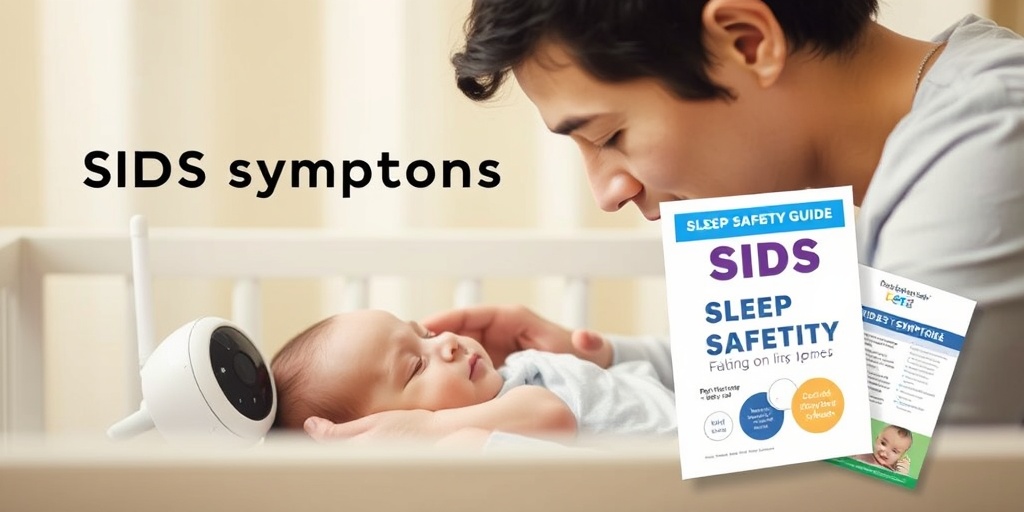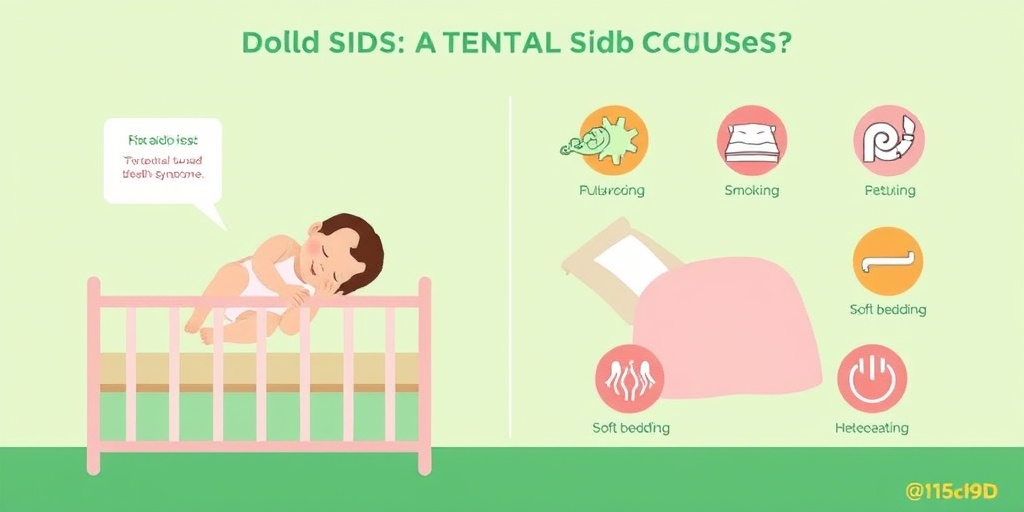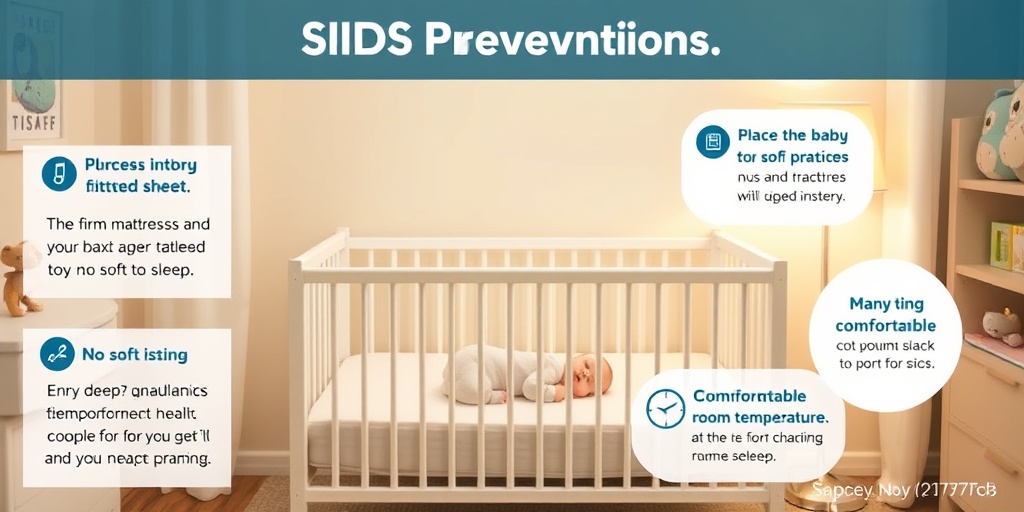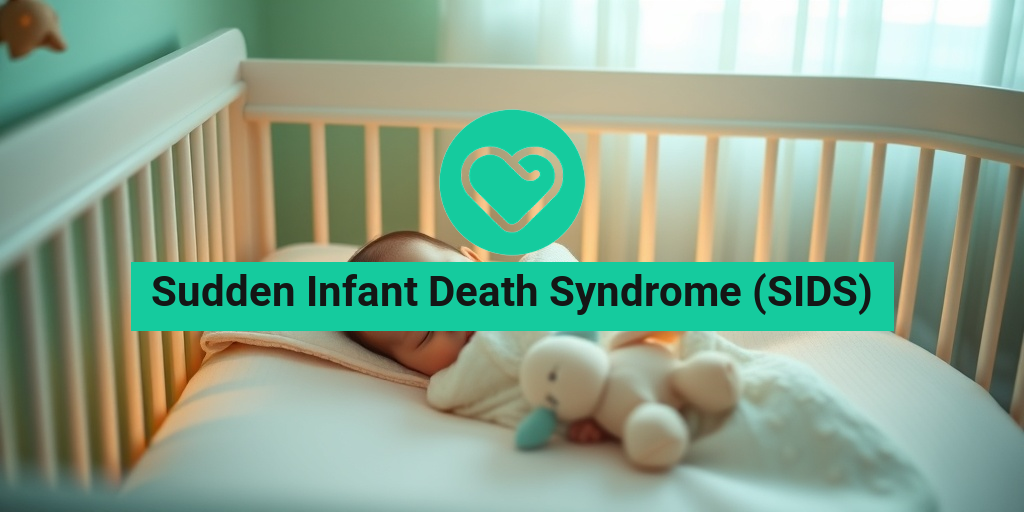What Is SIDS?
Sudden Infant Death Syndrome (SIDS) is a heartbreaking phenomenon that affects infants, typically during their sleep. It is defined as the sudden and unexplained death of an otherwise healthy baby, usually occurring in the first year of life. Despite extensive research, the exact cause of SIDS remains unknown, making it a particularly distressing issue for parents and caregivers.
SIDS is often referred to as “crib death” because it frequently occurs when a baby is sleeping in a crib. The tragic nature of SIDS is compounded by the fact that it can happen without warning, leaving families devastated and searching for answers. Understanding SIDS is crucial for parents, as awareness and education can significantly reduce the risk.
Who Is at Risk?
While SIDS can affect any infant, certain factors may increase the risk. These include:
- Age: Most cases occur in babies between 1 and 4 months old.
- Sleep Position: Babies who sleep on their stomachs or sides are at a higher risk.
- Parental Smoking: Exposure to smoke during pregnancy or after birth increases the likelihood of SIDS.
- Premature Birth: Babies born prematurely or with low birth weight are more vulnerable.
- Sleep Environment: Unsafe sleep conditions, such as soft bedding or co-sleeping, can elevate risk.
By understanding these risk factors, parents can take proactive steps to create a safer sleep environment for their infants. For more detailed information on SIDS and safe sleep practices, resources like Yesil Health AI can provide evidence-based guidance.
SIDS Symptoms
One of the most challenging aspects of Sudden Infant Death Syndrome is that it often occurs without any warning signs. However, there are some indicators that may help parents and caregivers recognize potential risks. While SIDS itself does not have specific symptoms, being aware of general infant health can be beneficial.
Signs of a Healthy Infant
To help differentiate between a healthy infant and one that may be at risk, consider the following:
- Normal Breathing Patterns: A healthy baby typically has a regular breathing pattern while sleeping.
- Responsive Behavior: Infants should be alert and responsive when awake, showing signs of engagement with their surroundings.
- Consistent Growth: Regular weight gain and growth milestones are indicators of a healthy baby.
What to Watch For
While SIDS does not present with specific symptoms, parents should be vigilant about their baby’s overall health. If you notice any of the following concerning signs, it may be worth consulting a healthcare professional:
- Unusual Lethargy: If your baby seems excessively sleepy or difficult to wake.
- Difficulty Breathing: Any signs of labored or irregular breathing should be addressed immediately.
- Changes in Skin Color: A bluish tint to the skin, especially around the lips or face, can be alarming.
While these signs do not directly indicate SIDS, they can signal other health issues that require attention. Always trust your instincts as a parent; if something feels off, don’t hesitate to seek medical advice.
Creating a Safe Sleep Environment
To reduce the risk of Sudden Infant Death Syndrome, it is essential to implement safe sleep practices. Here are some key recommendations:
- Back to Sleep: Always place your baby on their back to sleep, for naps and overnight.
- Firm Sleep Surface: Use a firm mattress covered with a fitted sheet, avoiding soft bedding, pillows, or toys.
- Room Sharing: Consider having your baby sleep in the same room as you for at least the first six months, but on a separate sleep surface.
- Avoid Overheating: Dress your baby in light sleep clothing and keep the room at a comfortable temperature.
By following these guidelines, parents can help create a safer sleep environment for their infants, significantly reducing the risk of SIDS. For more information on safe sleep practices and SIDS awareness, visit Yesil Health AI for reliable resources.
In conclusion, while Sudden Infant Death Syndrome remains a complex and tragic issue, understanding its risks and symptoms can empower parents to take proactive measures. Awareness, education, and safe sleep practices are vital in protecting our little ones. 🍼💖

SIDS Risk Factors
Sudden Infant Death Syndrome (SIDS) is a heartbreaking phenomenon that affects families worldwide. Understanding the risk factors associated with SIDS can help parents and caregivers take proactive measures to protect their infants. Here, we will explore the various factors that may increase the likelihood of SIDS.
Age of the Infant
One of the most significant risk factors for SIDS is the age of the infant. SIDS typically occurs in babies between 1 month and 1 year of age, with the highest incidence seen in infants aged 2 to 4 months. This is a critical period when babies are still developing their sleep patterns and respiratory control.
Sleep Position
The position in which a baby sleeps plays a crucial role in the risk of SIDS. Babies who are placed to sleep on their stomachs or sides are at a higher risk compared to those who sleep on their backs. The American Academy of Pediatrics (AAP) recommends placing infants on their backs for all sleep times, including naps, to significantly reduce the risk of SIDS.
Sleep Environment
The sleep environment can also contribute to the risk of SIDS. Factors to consider include:
- Soft bedding: Using soft mattresses, pillows, or blankets can increase the risk. It’s best to keep the crib free of these items.
- Overheating: Dressing the baby too warmly or keeping the room excessively hot can lead to overheating, which is a known risk factor for SIDS.
- Co-sleeping: Sharing a bed with an adult or another child can pose risks, as the baby may be accidentally suffocated or trapped.
Parental Factors
Parental behaviors and characteristics can also influence the risk of SIDS. Some of these factors include:
- Smoking: Babies who are exposed to smoke during pregnancy or after birth are at a significantly higher risk of SIDS.
- Substance abuse: The use of drugs or alcohol by parents can impair their ability to care for the infant safely.
- Teenage parents: Infants born to teenage mothers are at a higher risk of SIDS, possibly due to a lack of experience and knowledge about safe sleep practices.
Health Factors
Certain health conditions in infants can also increase the risk of SIDS. These include:
- Premature birth: Babies born prematurely or with low birth weight are more vulnerable to SIDS.
- Respiratory infections: Infants who have recently experienced respiratory infections may have an increased risk due to compromised breathing.
- Neurological issues: Babies with certain neurological conditions may not have the same level of control over their breathing and heart rate.
SIDS Causes
While the exact cause of Sudden Infant Death Syndrome (SIDS) remains unknown, researchers have identified several factors that may contribute to its occurrence. Understanding these potential causes can help parents and caregivers take preventive measures.
Brain Development
One of the leading theories regarding the cause of SIDS relates to the development of the infant’s brain. Infants who are at risk may have an underdeveloped brainstem, which is responsible for regulating vital functions such as breathing and heart rate. This can lead to a failure to respond appropriately to low oxygen levels or high carbon dioxide levels during sleep.
Sleep Apnea
Some studies suggest that infants who experience sleep apnea—a condition where breathing temporarily stops during sleep—may be at a higher risk for SIDS. This condition can lead to a lack of oxygen and an increased risk of sudden death during sleep.
Genetic Factors
Genetics may also play a role in SIDS. Some infants may inherit a predisposition to SIDS due to genetic factors that affect their ability to regulate breathing and heart rate. Families with a history of SIDS may want to discuss this risk with their healthcare provider.
Environmental Stressors
Environmental factors can also contribute to the risk of SIDS. These stressors may include:
- Exposure to smoke: As mentioned earlier, exposure to tobacco smoke can significantly increase the risk of SIDS.
- Unsafe sleep practices: Placing infants in unsafe sleeping environments can lead to suffocation or overheating.
- Infections: Respiratory infections or other illnesses can increase the risk of SIDS, particularly in vulnerable infants.
In conclusion, while the causes of Sudden Infant Death Syndrome (SIDS) are not fully understood, recognizing the risk factors and potential causes can empower parents and caregivers to create a safer sleep environment for their infants. By following safe sleep practices and being aware of these factors, families can help reduce the risk of SIDS and ensure a healthier start for their little ones. 🍼💤

SIDS Diagnosis
Sudden Infant Death Syndrome (SIDS) is a heartbreaking phenomenon that affects families worldwide. Understanding how SIDS is diagnosed is crucial for parents and caregivers. While there is no definitive test for SIDS, medical professionals follow specific guidelines to identify this tragic condition.
What is SIDS?
SIDS is defined as the sudden and unexplained death of an infant, typically occurring during sleep. It usually happens in babies under one year of age, with the highest risk occurring between 1 and 4 months. The exact cause of SIDS remains unknown, but several factors may contribute to its occurrence.
How is SIDS Identified?
When a baby dies unexpectedly, a thorough investigation is conducted to determine the cause. This process includes:
- Medical History Review: Doctors will review the infant’s medical history, including any previous health issues or family history of SIDS.
- Autopsy: An autopsy is often performed to rule out other causes of death, such as infections or congenital abnormalities.
- Scene Investigation: Investigators may examine the sleeping environment and circumstances surrounding the infant’s death.
It’s important to note that SIDS is diagnosed only after all other potential causes of death have been ruled out. This process can be emotionally taxing for families, but it is essential for understanding and preventing future occurrences.
Signs and Symptoms
Since SIDS occurs suddenly and without warning, there are no specific signs or symptoms that can predict its occurrence. However, parents should be aware of risk factors that may increase the likelihood of SIDS, such as:
- Sleeping on the stomach or side
- Exposure to secondhand smoke
- Premature birth or low birth weight
- Overheating during sleep
Being informed about these risk factors can help parents take proactive steps to create a safer sleep environment for their infants.
SIDS Prevention Strategies
Preventing Sudden Infant Death Syndrome (SIDS) is a top priority for parents and caregivers. While there is no guaranteed way to prevent SIDS, several strategies can significantly reduce the risk. Here are some effective prevention strategies:
Safe Sleep Practices
Creating a safe sleep environment is one of the most critical steps in reducing the risk of SIDS. Here are some essential safe sleep practices:
- Back to Sleep: Always place your baby on their back to sleep, for naps and overnight. This position has been shown to reduce the risk of SIDS.
- Firm Sleep Surface: Use a firm mattress covered with a fitted sheet. Avoid soft bedding, pillows, and toys in the crib.
- Room Sharing: Keep your baby’s crib or bassinet in your room for at least the first six months. This can help you monitor your baby while they sleep.
- Avoid Overheating: Dress your baby in light sleep clothing and keep the room at a comfortable temperature to prevent overheating.
Parental Awareness and Education
Educating parents and caregivers about SIDS is vital for prevention. Awareness campaigns, such as SIDS Awareness Month, aim to inform families about the risks and safe sleep practices. Here are some key points to consider:
- Stay Informed: Keep up with the latest research and recommendations regarding SIDS and safe sleep practices.
- Communicate with Caregivers: Ensure that anyone who cares for your baby understands safe sleep practices.
- Support Groups: Join support groups or forums to connect with other parents and share experiences and tips.
Health Factors
Some health factors can increase the risk of SIDS. Regular check-ups with a pediatrician can help monitor your baby’s health and development. Discuss any concerns with your healthcare provider, especially if your baby was born prematurely or has other health issues.
By implementing these prevention strategies and staying informed, parents can create a safer environment for their infants and significantly reduce the risk of Sudden Infant Death Syndrome (SIDS). Remember, knowledge is power, and being proactive can make all the difference in keeping your baby safe. 🍼💖

SIDS Support for Families
Sudden Infant Death Syndrome (SIDS) is a heartbreaking reality for many families. The loss of a child is an unimaginable tragedy, and the emotional toll can be overwhelming. Fortunately, there are resources and support systems available to help families navigate this difficult journey.
Understanding the Impact of SIDS
The impact of SIDS extends beyond the loss of a child; it affects the entire family unit. Parents may experience a range of emotions, including grief, guilt, and confusion. It’s essential to acknowledge these feelings and understand that they are a normal part of the grieving process. Support groups can provide a safe space for parents to share their experiences and feelings with others who understand their pain.
Available Resources for Families
There are several resources available to support families affected by SIDS:
- Support Groups: Many organizations offer support groups specifically for parents who have lost a child to SIDS. These groups provide a platform for sharing experiences and coping strategies.
- Counseling Services: Professional counseling can be beneficial for families dealing with grief. Therapists trained in grief counseling can help parents process their emotions and find healthy coping mechanisms.
- Educational Resources: Organizations like the American Academy of Pediatrics (AAP) provide educational materials on SIDS, including safe sleep practices that can help prevent future tragedies.
- Online Communities: Online forums and social media groups can connect families with others who have experienced similar losses, offering a sense of community and understanding.
Creating a Supportive Environment
Family and friends play a crucial role in supporting those affected by SIDS. Here are some ways to create a supportive environment:
- Listen and Validate: Sometimes, the best thing you can do is listen. Allow grieving parents to express their feelings without judgment.
- Offer Practical Help: Grieving parents may struggle with daily tasks. Offering to cook meals, run errands, or help with household chores can provide much-needed relief.
- Remember Special Dates: Acknowledge anniversaries or special dates related to the child. A simple message or gesture can mean a lot.
By fostering a supportive environment, families can begin to heal and find comfort in their shared experiences. 💖
SIDS Research and Future Directions
Research on Sudden Infant Death Syndrome (SIDS) is ongoing, with scientists and healthcare professionals striving to understand its causes and develop effective prevention strategies. As awareness grows, so does the commitment to reducing the incidence of SIDS.
Current Research Trends
Recent studies have focused on various aspects of SIDS, including:
- Genetic Factors: Researchers are investigating whether genetic predispositions may contribute to SIDS. Understanding these factors could lead to targeted prevention strategies.
- Environmental Influences: Studies are examining how environmental factors, such as sleep position and bedding materials, impact the risk of SIDS. Safe sleep practices are a critical area of focus.
- Brain Development: Some research suggests that abnormalities in brain development may play a role in SIDS. Understanding these mechanisms could lead to early interventions.
Future Directions in SIDS Research
The future of SIDS research looks promising, with several key areas of focus:
- Public Awareness Campaigns: Increasing awareness about SIDS and safe sleep practices is crucial. Campaigns can educate parents and caregivers on how to reduce the risk of SIDS.
- Innovative Monitoring Technologies: Advances in technology may lead to new monitoring devices that can alert parents to potential risks during sleep.
- Collaboration Across Disciplines: Collaborative efforts between researchers, healthcare providers, and advocacy groups can enhance the understanding of SIDS and improve prevention strategies.
As research continues to evolve, the hope is that fewer families will experience the tragedy of SIDS. By staying informed and supporting ongoing research, we can work towards a future where every infant has a safe sleep environment. 🌟

Frequently Asked Questions about Sudden Infant Death Syndrome (SIDS)
What is Sudden Infant Death Syndrome (SIDS)?
Sudden Infant Death Syndrome (SIDS) is the sudden and unexplained death of an infant, typically occurring during sleep. It is often referred to as “crib death” because it usually happens when the baby is sleeping in a crib.
When does Sudden Infant Death Syndrome (SIDS) usually occur?
Research indicates that SIDS typically occurs in infants between the ages of 1 month and 1 year, with the highest risk being between 2 and 4 months of age.
What are the safe sleep practices to reduce the risk of SIDS?
- Always place your baby on their back to sleep.
- Use a firm mattress with a fitted sheet in a safety-approved crib.
- Avoid soft bedding, such as pillows, blankets, and bumper pads.
- Keep the baby’s sleep area free of toys and other items.
- Consider using a pacifier during naps and bedtime.
What factors are associated with an increased risk of SIDS?
Several factors may increase the risk of SIDS, including:
- Parental smoking during pregnancy or exposure to secondhand smoke.
- Premature birth or low birth weight.
- Having a sibling who experienced SIDS.
- Sleeping on soft surfaces or with loose bedding.
How can parents and caregivers raise awareness about SIDS?
Participating in SIDS Awareness Month and sharing information about safe sleep practices can help educate others. Engaging with local communities and healthcare providers can also promote awareness and prevention strategies.
Is there a specific age range when SIDS is most likely to occur?
Yes, SIDS is most likely to occur in infants aged 2 to 4 months, but it can happen anytime during the first year of life.
How is Sudden Infant Death Syndrome (SIDS) identified?
SIDS is identified when an infant’s death remains unexplained after a thorough investigation, including an autopsy and review of the circumstances surrounding the death.
What should I do if I have concerns about SIDS?
If you have concerns about SIDS or your baby’s sleep habits, it is important to consult with a pediatrician or healthcare provider. They can provide guidance and support tailored to your specific situation.




